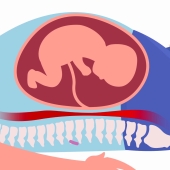Nitrous Oxide (N20) is otherwise known as laughing gas. It is an anaesthetic gas that has been used since the beginning of the last century. It is commonly used during surgery and as a pain relief method during labour.
The effectiveness of Nitrous Oxide as pain relief in labour varies from woman to woman. Less than 50 per cent of women find it a satisfactory form of pain relief, 20 per cent obtain some pain relief for some of the time and around 30 per cent find it totally ineffective.
While you may associate laughing gas more with cavities than babies, nitrous oxide is moving from dentist office to delivery room. “They inhale the nitrous oxide maybe 30 seconds before the peak of a contraction and as opposed to having the severe pain it’s almost like a relaxation state that they go in,” says Dr. Fleishman.
Moms are awake, alert and in control. The gas quickly exits their system. “A woman breathes off the nitric oxide within 50 seconds, it’s gone, it’s out of the body and it doesn’t affect the baby,” says Dr. Fleishman. Trends show more women are seeking a natural childbirth experience. This helps them achieve that without the needles and narcotics used in other pain relievers.
“The most common is an epidural, which makes women numb from the waist down. Women can lose a sense of control because it’s hard to push. The other option is IV medication, but it can make the mother feel groggy and out of it,” says Dr. Fleishman.
Both safe and effective, but with its short duration, gas minimizes pain and still allows mom to feel the experience. “Doing things like skin-to-skin contact immediately, clamping and bonding and breastfeeding very soon after the birth,” says Dr. Fleishman.
What are the advantages of using Nitrous Oxide during labour?
- The advantages of using Nitrous Oxide during labour is that it provides some pain relief for some women.
- Women using Nitrous Oxide remain awake and in control of their own pain relief.
- Nitrous Oxide does not interfere with contractions, the time Nitrous Oxide remains effective is short and there are no obvious short term effects on mother and baby that have been noted to date.
What are the disadvantages of using Nitrous Oxide during labour?
- Nausea and/or vomiting
- Not a reliable form of pain relief
- Women can become drowsy, confused or disorientated. Some women experience these feelings as quite unpleasant
- The face mask can make some women feel claustrophobic.
- 31 views













